The safest options for sealing wooden toys are the all-natural food-safe options listed below. The natural oils, waxes, and soap finish would be the purest options.
There are non-toxic sealers that are synthetic – acrylic sealers can be certified Toy Safe.
I will mention how each type affects the color and sheen of the wood and how durable it is.
I use both food-safe designation (FDA) and Toy Safe Certification (Europe) to assess the products. These two certifications allow us to know if the product is baby-safe and child-safe in case it is chewed on.
Toy Safe Standard EN-71 simulates ingestion of the paint in humans so that we know they are safe if they get chewed. It shows that the products are free of any substantial amount of aluminum, antimony, arsenic, barium, boron, cadmium, Chromium (III), Chromium (VI), cobalt, copper, lead, manganese, mercury, nickel, selenium, strontium, tin, organic tin, and zinc.
This article contains affiliate links, upon purchase I make a small commission at not extra cost to you.
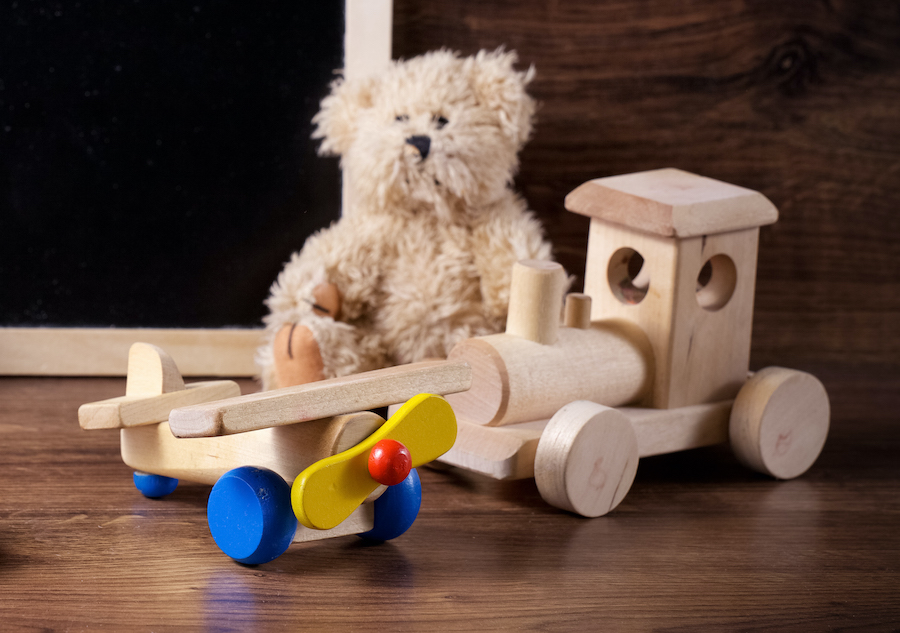
1. Natural Penetrating Oils
Linseed Oil and Tung Oil

Tung and Linseed Oil are the more durable oils for protecting wooden toys and play sets.
Penetrating “drying oils” polymerize, leaving a durable yet matte finish. They do change the color of the wood, with tung oil producing the darkest color change, followed by linseed, then hemp, then walnut.
Pure Tung Oil
Tung provides the most durable finish of the oils and can be used for indoor and outdoor toys/pay-sets. And Linseed is not far behind in durability.
Tung oil from The Real Milk Company is food-safe. Tung oil is very thick so it is usually cut down with a solvent when used on wood.
I prefer to use 100% natural tung oil without a solvent whenever possible. But if you need a solvent be sure to use the food-safe citrus solvent (which is all-natural) and give it time until it only has a very slight citrus aroma left. (The full cure time for both tung and citrus oil is 30 days).
There is a chance of allergic reaction to tung oil, though it’s very rare. It’s even rarer to have an allergic reaction if the oil is given time to fully cure.
Pure Linseed Oil
Linseed oil comes in different formulations, for toys, there are two options.
The first is 100% linseed oil that is labeled food contact safe. This natural and pure type is called polymerized linseed oil, and the best brand is Tried and True Danish Oil. It does not contain driers, solvents, or any other additives.
It does come in variations that have added pigments if you want to get a stained look. Though the stains are not certified Toy Safe, so we can’t be sure they are safe.
Rubio Monocoat
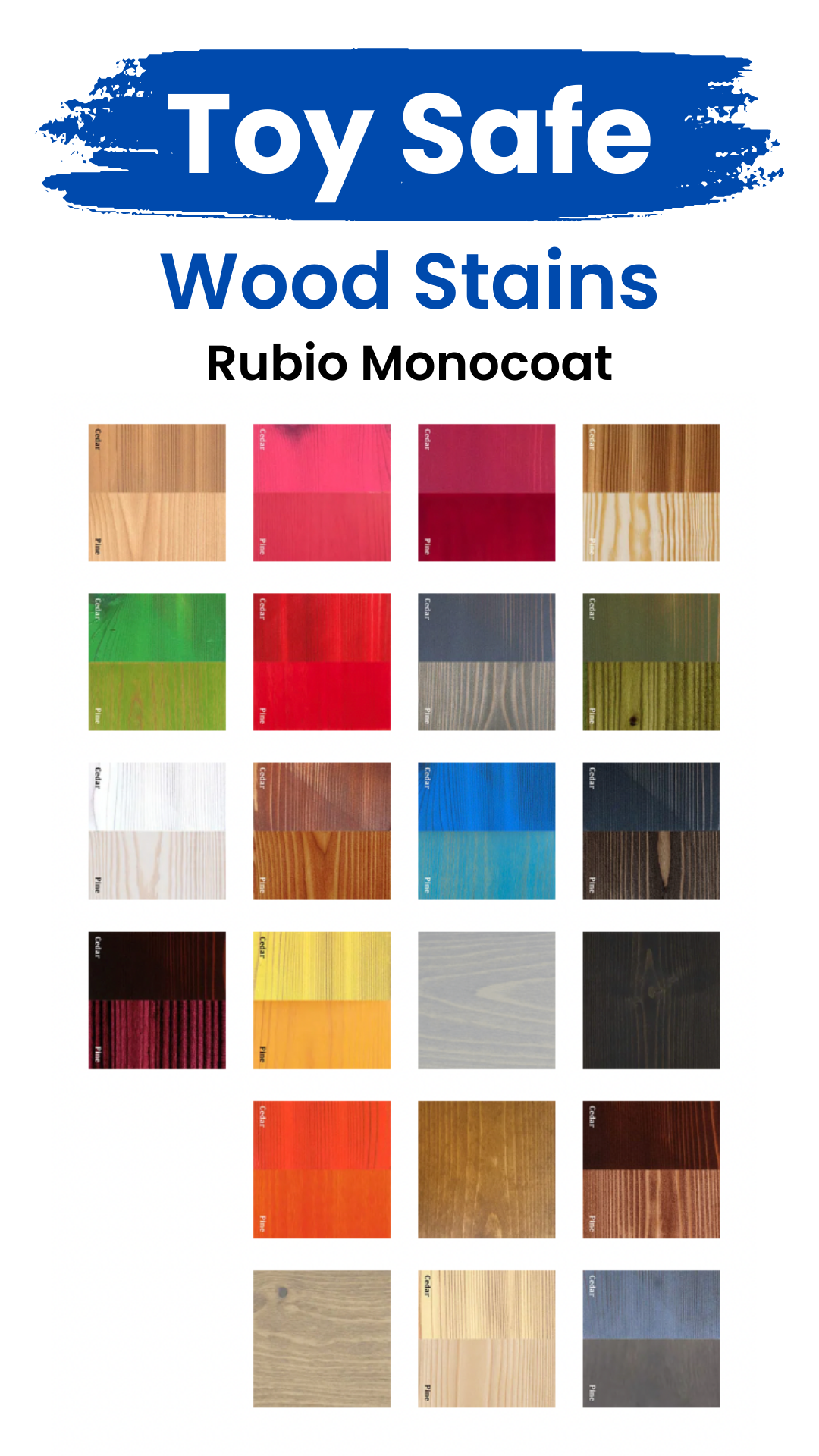
Rubio Monocoat is a modified linseed oil. It also contains beeswax and carnauba wax. The accelerator is optional and if you want to stay as clean and natural as possible I would avoid it.
We don’t have a complete list of ingredients in Rubio Monocoat, but all colors of their indoor stain and exterior stain are certified Toy Safe EN-71.
Toy Safe Standard EN-71 simulates ingestion of the paint in humans and products are free of any substantial amount of aluminum, antimony, arsenic, barium, boron, cadmium, Chromium (III), Chromium (VI), cobalt, copper, lead, manganese, mercury, nickel, selenium, strontium, tin, organic tin, and zinc.
Be very particular about the brands of oils you use, making sure that it is either food contact safe or Certified Toy Safe. Linseed oil with manganese driers would not likely be considered Toy Safe by European Standards.
Hemp Oil and Walnut Oil
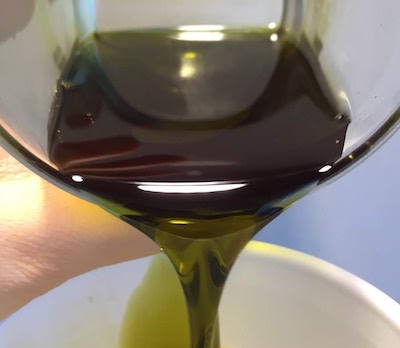
Hemp and walnut oil are milder in odor and are also less durable. But for wooden toys used indoors, these will work just fine, especially if they are not frequently getting soaked.
I have used hemp oil myself, as it’s still a great all-natural choice in terms of durability and mild odor. There is no risk of a nut allergy.
I also really like the Real Milk Company’s food-safe walnut and carnauba wax and have used it on many small projects like toys and decor items myself, but it’s the least durable of the natural oils. The wax gives it a bit of a satin sheen.
This company makes really high-quality pure products.
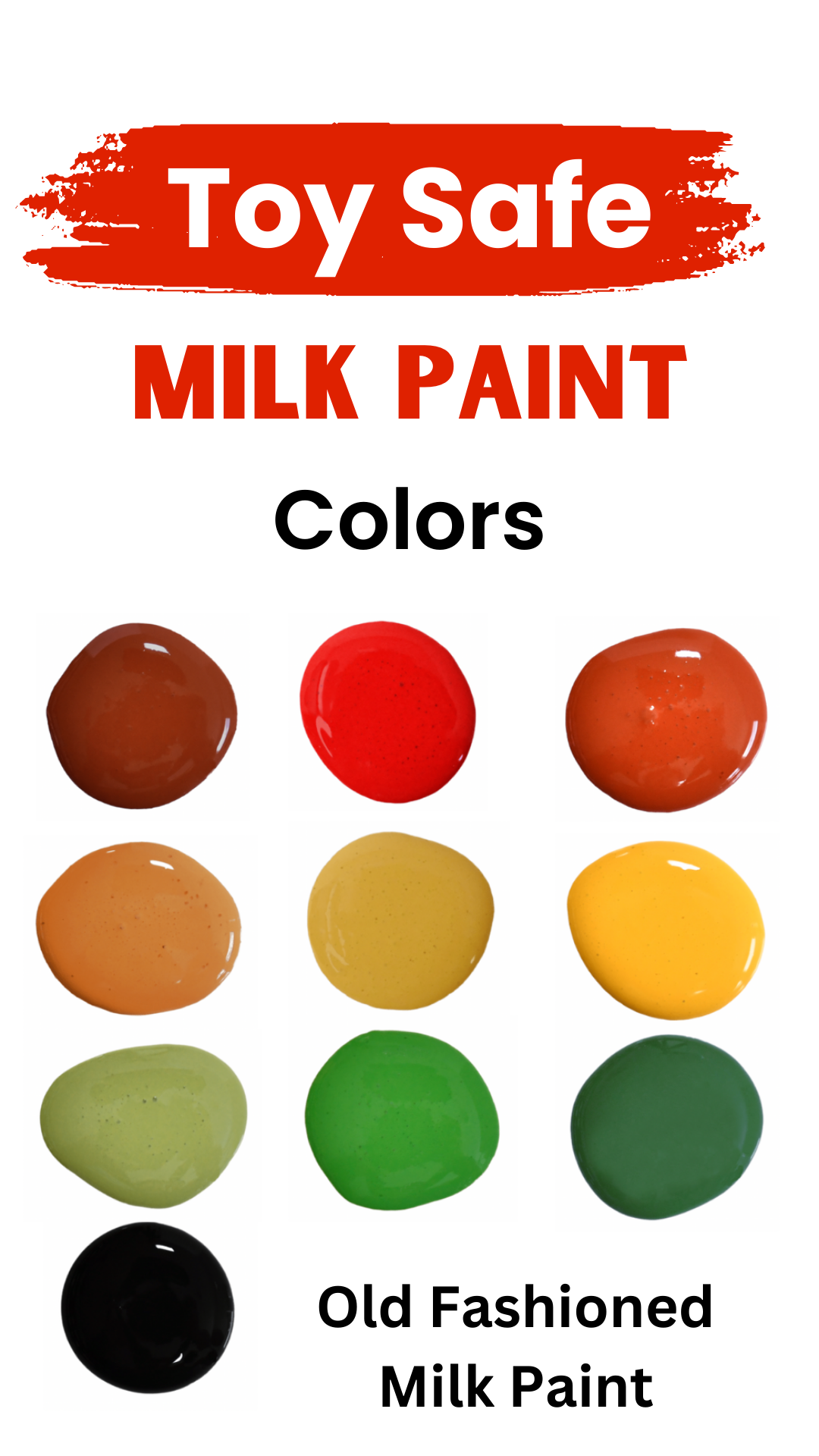
Want more of a stain color? Use a Milk Paint “wash” as a stain on wood by diluting it with more water than you would use to make milk paint. You can then topcoat that with a penetrating oil on this list.
The Toy Safe EN-71 colors are: Scarlett (bright red), Marigold Yellow, Mustard, Pumpkin, Salem Red, Barn Red, Bayberry Green, Tavern Green, Lexington (dark green), and Pitch Black.
3. Shellac
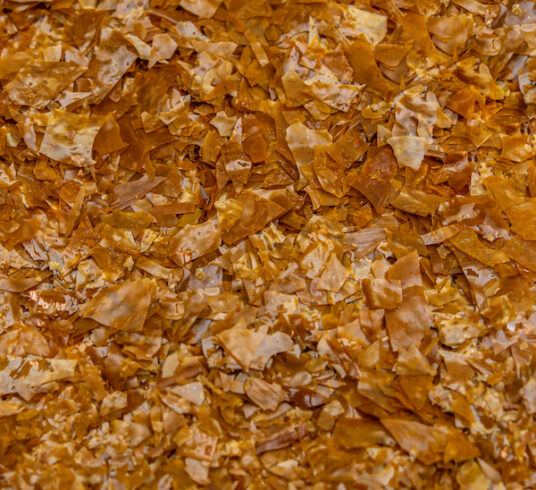
Shellac is a natural resin that comes from a beetle mixed into alcohol. Shellac as an ingredient is considered food contact safe (it is also used directly on food, like to coat candies and apples).
You can buy it premixed, though those brands are not food contact safe. For toys, go with the all-natural version – buy the flakes from Wellermart which states it’s food safe, and mix them yourself with Everclear alcohol.
This is a shiny finish and at least slightly amber (depending on the color of the flakes that you buy). It’s for indoor toys only.
Added Benefits
One added benefit of shellac is that it is great at sealing in odors and sealing in questionable chemicals. If you have wooden toys with some chemicals: pesticide residue, fragrance cross-contamination, or anything else it might have picked up along the way, shellac can help add a layer of protection.
It can also form a layer of protection over synthetic paints or natural pigments.
Layering Shellac
You can use shellac over a penetrating oil finish, for more durability. I often layer it that way.
A durable sequence that I like is Milk Paint (toy-safe colors only, see above) + tung oil + shellac.
You can also add pigments to shellac to make a stain. More on that here.
4. Natural Wax Finish
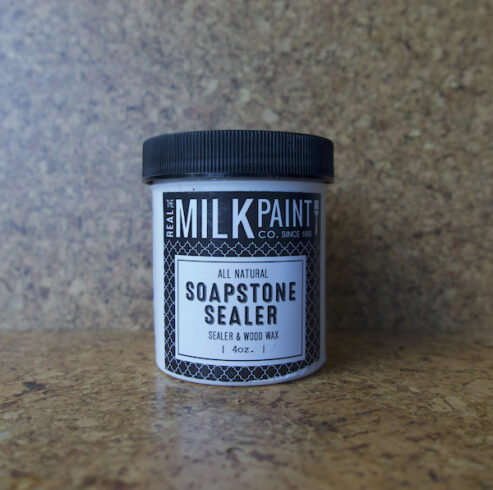
Often a natural wax like beeswax or carnauba is mixed into a penetrating oil finish like the carnauba wax + walnut oil mentioned above.
Carnauba is categorized as GRAS (generally regarded as safe i.e. food safe).
Tried and True has a food-contact-safe linseed & beeswax finish, Fusion makes a food-contact-safe hemp oil & beeswax finish, and Real Milk Paint makes a food-contact-safe walnut oil & carnauba wax.
I would avoid waxes that are mixed with mineral oil, as they are not all food-safe.
5. Danish Soap Finish

Danish Soap finish is an unusual non-toxic way to finish wood. It is a process that uses pure soap as the finish.
You can either use just soap, or soap and lye.
Lye is quite toxic while it’s reacting, just make sure to let it dissipate fully.
When used in the making of soap the lye reacts with other components and in the end, you just have a soap finish.
Compared to the natural oils and wax finishes this option does not provide any sheen, darkening, or yellowing. Oils are always at least a little bit yellow/amber and darken the wood. Both oil and wax add various levels of sheen, depending on which product is used.
Danish Soap finish is flat and has an invisible look.
It is high-maintenance though, and not as durable as the other options.
Pure soap is food contact safe.
6. Non-Toxic Synthetic Sealant
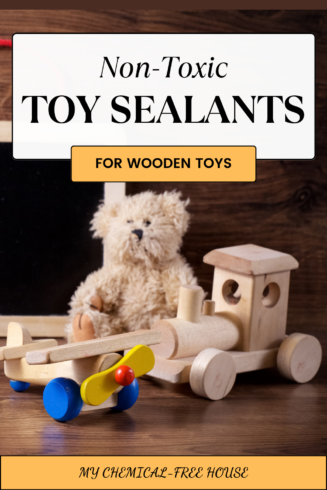
You can go with Toy Safe or food contact safe acrylic, polyurethane, or polyacrylic finishes for wood toys.
ECOS products are Certified Toy Safe (European standard EN-71).
ECOS Paints makes great low-toxin finishes, both stains and clear finishes. They are zero-VOC after curing, they have great transparency in ingredients (which is rare), and they are a favorite among the chemically sensitive.
Another Toy Safe Certified acrylic sealant is AFM Safecoat Acriglaze (matte finish).
Acrylic finishes are not quite as durable as polyurethane.
Related Posts:
- Non-Toxic Paints for Wooden Toys
- Non-Toxic Paints for Plastic Toys
- Natural Wood Stains
- Food Grade Paints
Corinne Segura holds certificates in Building Biology, Healthier Materials and Sustainable Buildings, and more. She has 10 years of experience helping others create healthy homes.

A Paranoid Mom
Thank you for this article Corinne! I purchased a wooden toy for indoor use, and I love it BUT there are rough areas that are not made better with sanding. Is there a child safe coating I can use that is THICK enough to prevent splinters? I don’t care about color, and the toy will rarely be chewed or wet. Thanks so much! I’ve been looking everywhere.
A Paranoid Mom
I’m willing of course to do
multiple coats!
Andy Tamas
Smoothing rough areas varies with the type of wood. What wood is the item made from? Butternut, for example, is a semi-hardwood with a beautiful grain, but it is hard to sand to a smooth finish unless you use 400 grit sandpaper for the final finish….. then it becomes smooth and should take a finish. I use butcher block or salad bowl oil on the toys I make and they work fine.
Blanca
Hello,
What would be the best option to seal a children’s wood mud kitchen (water play)?
Corinne
the post covers your options but you will need to know if it already has a finish on it and if it will be used outdoors or only indoors.
Blanca
Yes–thank you. I decided to go with Tried & True Polymerized Linseed Oil. Our mud kitchen is unfinished wood. Mud Kitchen will be outdoors in a covered patio (no direct sun or rain). Hoping the oil will help make it water-resistant for water play.
Corinne
that’s an indoor finish
ANTOINETTE
HELLO, IM A STRESSED OUT GRANDMOTHER – I PURCHASED PAINTED WOODEN TOYS IN SOUTH AMERICA AT A STREET FAIR. IT DAWNED ON ME THAT THE PAINT COULD BE TOXIC SO IM THINKING OF USING SHELLAC PER YOUR ARTICLE. DO YOU THINK THAT WILL OFFER ENOUGH PROTECTION OR SHOULD I TOSS THE TOYS?
Corinne
The paint could contain lead, if the toys will be chewed on then they should not be used by the kids. if not chewed on you need a lead encapsulation sealer like this https://www.leadclearpaint.com/
Corinne
I should also add the you need to check it that is a compatible sealer with the paint that is already on there. If it’s oil based paint then it’s more complicated.
Mary
Can you apply tung oil over ECOS paints? Thanks
Corinne
It would work better to use a thinner oil like hemp oil or walnut oil, wipe off the excess, and it will yellow it, but it can work.
Julie
I don’t see any wood stains mentioned here. Did I miss something?
Corinne
There are three mentioned
Reema
Hi! I am painting some wooden blocks and then want to put a finish on it for my one year old. Will hemp work for that or will the paint also get dark? I can’t figure out what would be best. The wood will not be getting wet but he may put it in his mouth…
Corinne
Depends on what kind of paint it is. Most paint does not need a sealer. If it’s milk paint then hemp oil is a good sealant.
Rachel Quigley
I goofed, I mean will water-based polyurethane seal in odors or toxins in WATER-BASED wood floor stain? Thanks
Rachel Quigley
Please tell me if water-based polyurethane would seal in any odors or toxins in oil-based wood floor stain (like Minwax). I have a few other questions and will pay for a consultation if you are available.
Thanks, -Rachel